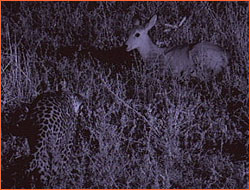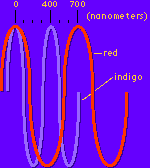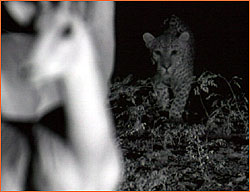
|
 |
 |
by Rob Meyer A leopard silently stalks its prey. Controlling every muscle in its body, it inches its way towards an antelope oblivious to impending doom. Any sound will give the leopard away, but this expert hunter is as careful as it is patient. Slowly, the leopard moves closer to the antelope, until it stands just feet away, ready to strike. The scene unfolds so slowly and dramatically it might seem to you a nightmarish fantasy—one of the most remarkable exchanges in nature. There is only one problem. You can't see a thing. The leopard's enormous eyes are capable of vast dilation, which allows the predator to see in near-lightless conditions. Human eyes, like the eyes of the leopard's prey, become useless in low light. Until recently, this meant that we had no way of observing the night behavior of leopards. Today, infrared-sensitive cameras enable us to record on videotape what we are unable to see with our eyes.
Looking at a chart, one quickly realizes that the wavelengths we can see make up a very small portion of the total spectrum. As the waves get longer than red, they become so-called "near-infrared" waves, then infrared waves, microwaves, and lastly radio waves. As they get shorter than indigo, they become ultraviolet waves, X rays, and finally gamma waves. These waves surround us all the time, but we are unaware of their presence, since they are not in our visible light spectrum. 
Near-infrared waves behave much like the light waves that we can see. They come in a range of lengths, and are absorbed and reflected by objects. But for our purposes there is one critical difference: They go undetected by humans, leopards, and antelopes. This is great news for producers who are looking to capture the behavior of wildlife at night. For the NOVA film Leopards of the Night, producers Amanda Barrett and Owen Newman brought security cameras to Africa (see Behind the Scenes). They were not paranoid that their equipment would be stolen. Instead, they had their minds on stealing something for themselves: nighttime video images. While our eyes cannot see waves longer than 700 nanometers, certain security cameras are sensitive to waves well into the near-infrared range. In order for these cameras to record dramatic wildlife scenes, near-infrared waves are needed to "illuminate" the subjects. Barrett and Newman relied on special lights as a source for these necessary waves. These lights, called infrared illuminators, use LEDs (light-emitting diodes) and are designed to produce light of particular wavelengths. In this case, they emit waves between 800 and 900 nanometers, right in the near-infrared range. While no visible light is emitted, the area is flooded with these invisible waves. The animals remain totally unaware of this illumination and go about their business in the dark. But as with visible light, their bodies absorb or reflect these near-infrared waves, depending on what part of the animal the waves bounce off.
Rob Meyer is Production Assistant of NOVA Online. Night Vision | Camera that Caught a Leopard Behind the Scenes | Seeing through Camouflage Resources | Transcript | Site Map | Leopards Home Editor's Picks | Previous Sites | Join Us/E-mail | TV/Web Schedule About NOVA | Teachers | Site Map | Shop | Jobs | Search | To print PBS Online | NOVA Online | WGBH © | Updated November 2000 |
 Muscles tensed, a leopard prepares to pounce on a
puku fawn that cannot see it in the pitch dark.
Muscles tensed, a leopard prepares to pounce on a
puku fawn that cannot see it in the pitch dark.

 Focusing the infrared-sensitive camera, which had no
viewfinder, was a constant challenge for cameraman
Owen Newman.
Focusing the infrared-sensitive camera, which had no
viewfinder, was a constant challenge for cameraman
Owen Newman.